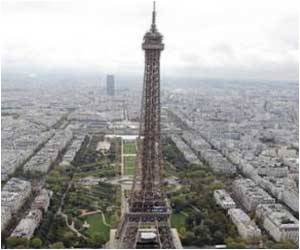What do Las Vegas, Hangzhou, Tokyo and Tegucigalpa have in common?

The imposing iron tower is probably the most copied monument in the world, but even SETE, the company that runs the structure, says it is impossible to know exactly how many other versions there are across the world.
Some of these faux-Eiffels have become famous in their own right, like the Tokyo tower and the huge replica on the Las Vegas Strip.
Others are more modest or kitsch, and can be found in some rather surprising places, such as the Bolivian capital, a public garden by the Black Sea in Bulgaria, or even a UN peacekeeping base in Lebanon.
Paris's "Old Iron Lady" is a huge seller. AFP has great demand for photos of the 125-year-old lattice structure, and replicas pop up in dozens of theme parks and in advertising campaigns the world over for just about any business imaginable.
Inaugurated in 1999, the replica Eiffel Tower at Paris Las Vegas was initially supposed to be even taller than the original, which soars 324 metres (1,063 feet) into the sky ?- including the antenna at the top. But architects had to trim their ambitions in half because of its proximity to the city's airport.
Advertisement
Tokyo's tower, built in 1958 and painted red and white, is one of the few copies to exceed the original in height, reaching 333 metres, though this was temporarily reduced to 312 metres in 2011 after the antenna was damaged in an earthquake and taken down for repair. This television tower remains a symbol of the Japanese capital, even though the Tokyo Sky Tree tower, which was completed in 2012, is nearly twice as tall.
Advertisement
There are other towns named Paris, and some of these have their own towers. Parizh, at the foot of the Urals in southern Russia, was founded in 1842 to commemorate the Russian victory over Napoleon's army 30 years earlier. Today it has a mobile phone mast, built in 2005, that looks like the Eiffel Tower.
'The price of success'
There have never been copyright restrictions on the original structure built in 1889. From the street hawker selling trinkets to tourists in Paris, to chocolate makers and megalomaniac real-estate developers ?- anyone is free to copy the tower.
But, the name "Eiffel Tower" is a registered trademark. Anyone who wants to, say, name a perfume or a restaurant after the structure must pay royalties -? how much depends on the size of the venture.
Similarly, the tower's dazzling golden lighting, designed by the engineer Pierre Bideau and inaugurated on New Year?s Eve 1985, is seen as an "oeuvre de l?esprit" ?- or an intellectual work ?- and so reproduction is not allowed.
What do those who run the Eiffel Tower think of all these imitations? "We're delighted," says Jean-Bernard Bros, the president of the SETE company in charge.
"That's just the price you pay for success," he told AFP. "The Eiffel Tower is imitated, copied, reproduced but never equalled. The replicas make people want to come to Paris to see the original. Our Eiffel Tower is something no one else can ever take from us, it is Paris."
Source-AFP








